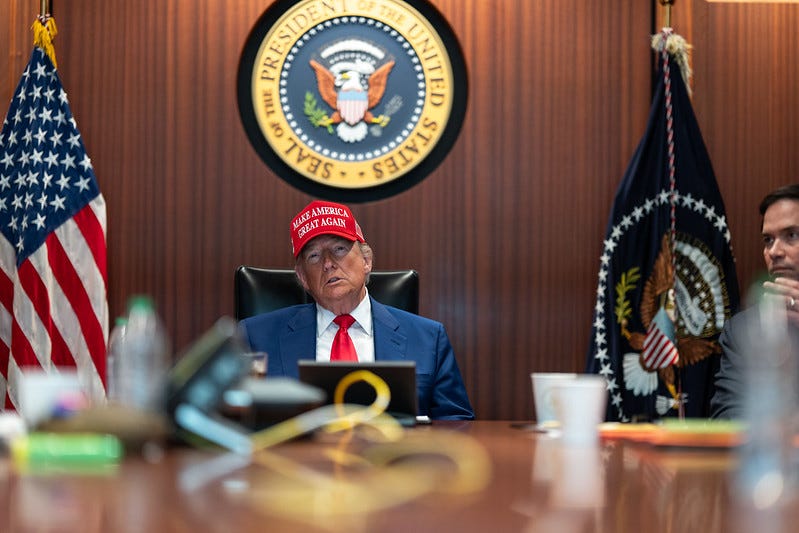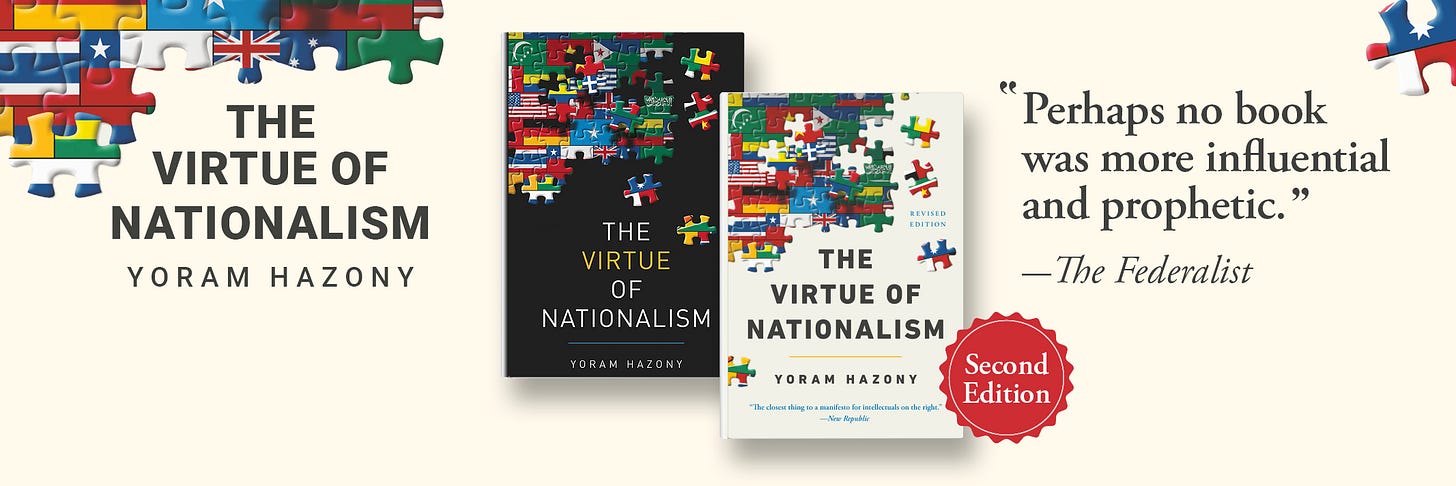The Iran Strikes and the Trump Doctrine
The three principles governing America’s new theory of foreign alliances.

A version of this essay appeared in The Free Press on July 1, 2025.
On June 21, the U.S. launched a meticulously planned strike on Iran’s nuclear weapons program. Ahead of the attack, skeptics warned that by bombing Iran, President Donald Trump would be starting another “forever war.” But a ceasefire followed less than 48 hours later. The United States reportedly used some 75 munitions on targets in Iran, before declaring the country’s nuclear weapons program devastated and the central aim of the campaign against Iran achieved.
Both before and after the strike, the public debate over President Trump’s decision has been largely conducted as though he had to choose between two competing foreign policy frameworks: a liberal internationalist (or “neoconservative”) policy, whose advocates press the administration to overthrow authoritarian regimes and rebuild them as liberal democracies; and an isolationist (or pacifist) policy, which assumes the U.S. has few genuine interests in Europe, the Middle East, or South Asia, and that the right thing to do is almost always to “stay out of it.”
The trouble is that neither President Trump nor key figures in his administration, such as Vice President J.D. Vance, Secretary of State Marco Rubio, or Defense Secretary Pete Hegseth, seem inclined to accept the simplistic neocons vs. isolationists binary that the media has been trying to impose on them. Republican voters are not sold on it either.
As the Iran strikes demonstrate, President Trump is guided by an entirely different strategic vision—a nationalist foreign policy that neither the liberal mainstream media nor the alternative media on the right seem very interested in discussing. Perhaps the Iran strike has finally gotten their attention, and a more serious conversation about U.S. foreign policy will now be possible.
In recent years, Trump-friendly writers and foreign policy thinkers have been working to describe and articulate what they understand to be a third, distinct theory of foreign policy. Michael Anton, now director of the State Department’s policy planning staff, named it the “Trump Doctrine” in an essay in Foreign Policy in 2019. Elbridge Colby, now the undersecretary of defense for policy, published his influential book on the subject, The Strategy of Denial, in 2021. David Goldman, now senior adviser on the State Department’s policy planning staff, likewise contributed a crucial book on countering China, You Will Be Assimilated: China’s Plan to Sino-Form the World, in 2020. My own 2018 book, The Virtue of Nationalism, also addresses the question of what a nationalist foreign policy looks like.
So what is the Trump Doctrine? As described by Anton and others of this school, it starts with a recognition that the post-Cold War “liberal internationalist” project had been a resounding failure. That policy, with its promise of a U.S.-led liberal empire backed by NATO, the EU, and other supranational institutions, has delivered neither peace nor stability. Instead, it produced a long series of reckless interventions in Iraq, Afghanistan, Libya, Syria, and other countries that cost millions of lives and trillions of dollars, eroding the moral confidence of Western nations and leaving their international position far weaker than when they embarked on these actions.
In place of liberal internationalist principles, the Trump Doctrine is founded on the following premises:
1. Resources really are scarce. The heart of the nationalist critique of liberal internationalist foreign policy is that it implicitly assumed unlimited resources. Foreign wars and externally induced “regime change” operations were pursued as though America could be everywhere. But in reality, America’s ability to deploy troops and manufacture munitions, to fund foreign wars, and to devote presidential attention to winning and ending them is severely limited. Given those limits, why should America accept primary responsibility for the security of regions more than wealthy enough to provide for their own defense?
2. China must be the focus of U.S. foreign policy. Nationalist writers have consistently been troubled by the liberal internationalists’ willingness to regard almost every region of the world as strategically significant, and every war as strategically necessary. The principal consequence of this flattened understanding of foreign affairs is that for most of the last 35 years, the United States was preoccupied and distracted while America’s great adversary, Communist China, was permitted to grow economically and militarily to the point that it now poses a genuine and unprecedented threat to the United States. America must recalibrate foreign and domestic policies to address its Chinese rival—or find itself overtaken.
3. Real allies must be regional powers, not protectorates. America has permitted and even encouraged its Cold War allies in Europe to dismantle their armed forces, military industries, and cultures of patriotism and military service. As a result, these “allies” became helpless protectorates and dependencies. The United States must reverse this trend, helping build up regional powers that are capable of taking primary responsibility for their own security and that of their regions. In so doing, they would advance America’s interests, but at a drastically lower cost to the United States.
The Trump Doctrine is not, in other words, a compromise between the “principled” positions of the liberal internationalists, on the one hand, and those of the isolationists, on the other. It is a principled foreign policy of its own, built on a completely different set of principles.
It is a nationalist foreign policy for two reasons: first, because it focuses attention on America’s national interests, rather than on attempting to provide security for the entire world. And second, because it is built on the principle that powerful, independent nations taking primary responsibility for their own defense are the most prudent path to securing American interests overseas, and, in fact, the only allies worth having.
Consider the Israeli-Iranian War from the perspective of the Trump Doctrine.
For 20 months, beginning with Hamas’s invasion of Israel on October 7, 2023, Prime Minister Benjamin Netanyahu’s government has demolished the Iranian war machine and its proxies—destroying the offensive capabilities of Hamas, Hezbollah, and Syria, and finally those of Iran itself. Through all of this, Israeli forces have fought almost alone.
True, the militaries of American, European, and Middle Eastern states have been active in helping Israel shoot down incoming ballistic missiles and drones. But the harrowing offensive operations Israel has conducted against Iran and its proxies have been carried out by the Israeli army, navy, air force, and Mossad without the participation of combat forces of any other nation. The thousands of casualties have been fully shouldered by Israeli troops, most of them reservists leaving their families and their businesses for months on end to engage in military operations on half a dozen fronts across the Middle East.
In short, Israelis have had help from their friends. But they have largely fought this war alone, acting as a regional power securing not only Israeli interests, but those of the Gulf States and other countries throughout the Middle East that have not been able to effectively resist Iran’s imperial aspirations.
This brings us to the question of Trump’s decision to bomb the strongly fortified Iranian nuclear facilities in Fordow, Isfahan, and Natanz. Although the administration has been providing Israel with weapons, intelligence, and logistical support, the involvement of American combat forces in the campaign against Iran has thus far been restricted to the use, on one occasion, of offensive weapons such as the B-2 bomber and the 30,000-pound bunker-buster munitions that Israel does not have, and which the Americans prefer to operate themselves.
Notice what is not being discussed after President Trump’s 37-hour-long operation against Iran. We see no indication that the Trump administration is contemplating a military occupation of Iran. There has been no talk of nation-building blueprints being prepared for American forces to take with them to Tehran. The Trump administration does not want to be the world’s policeman. It doesn’t have any interest in being the world’s schoolteacher either, feeding Enlightenment liberalism to recalcitrant Islamist radicals.
What President Trump does want is for aggressive powers that kill Americans and pose a threat to American interests to be dealt with in some way. This is why he has worked consistently, beginning with the Abraham Accords negotiated during his first term of office, to establish a new alliance system for the Middle East—one in which Israeli military and technological prowess will be combined with the wealth and prestige of the Gulf States to counter the threat from Iran. In other words, the Abraham Accords provide a model for how a rising regional power, Israel, can become the cornerstone for a regional security system that can relieve the United States of primary responsibility for Middle East security.
Viewed from this perspective, the Trump administration’s strike on Fordow and Isfahan is seen as a limited effort to strengthen the emerging regional alliance augured by the Abraham Accords. In the days leading up to June 21, Israeli officials had repeatedly signaled their willingness to go it alone, attacking Fordow and other Iranian nuclear sites using the difficult bombing techniques and commando operations that Israel had successfully employed in operations in Lebanon and Syria over the last year. But the Trump administration evidently concluded that an Israeli solo effort was too risky and that a surgical U.S. strike with specialized American weapons could have extensive long-term benefits for the regional alliance emerging from the Abraham Accords and for America itself.
When the Trump Doctrine is put into practice, this kind of limited operation to bolster a regional military power and strengthen an emerging regional alliance may sometimes be a bet worth taking.
The same principles apply in other parts of the world. Consider Poland, a country of 38 million people where there are currently 10,000 U.S. troops stationed. The dramatic increases in Poland’s defense spending since 2022 (already approaching 5 percent of GDP, comparable to Israel’s defense budget in 2023) signal that Warsaw sees itself as a potential regional power—one that knows the danger of Russian expansionism intimately, and is moving toward assuming primary responsibility for regional security in Eastern Europe. The Poles’ determination to attain national self-reliance, and the prospect of bringing those American soldiers home, is exactly what makes Poland an attractive potential ally under the Trump Doctrine.
This is the context for last week’s public announcement by NATO countries that they intend to follow Poland’s lead and aim for defense budgets of 5 percent of GDP by 2035. For Britain, France, and Germany, currently spending around 2 percent of GDP on defense, and for Italy, currently spending 1.5 percent, this would amount to a fundamental revision of their relationship with military power. For U.S. foreign policy under the Trump Doctrine, this is a test of whether any of these countries can remake themselves into allies worth having.
A nationalist foreign policy starts with the understanding that the world is not a homogeneous blob of converging liberal democracies, but a collection of distinct nations, some of them powerful and motivated enough to become regional powers that can advance American interests.
According to the Trump Doctrine, America’s role in such a world is focused on countering China and on rebuilding itself at home. Beyond that, America will be interested in alliances with powerful, independent nation-states that can take care of themselves and their regions, coordinate with each other where beneficial, and look to America to supplement their strategic capabilities where necessary. That is how to understand the Trump administration’s limited intervention in Israel’s war with Iran—a move that teaches us a great deal about how the United States is likely to view foreign policy from now on.







Very helpful essay. Also, the approach it describes sounds eminently sensible.
https://open.substack.com/pub/majortruthache/p/when-the-world-fills-with-hamas?utm_source=app-post-stats-page&r=1gcprx&utm_medium=ios